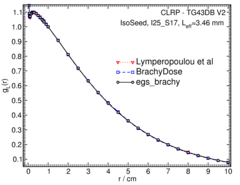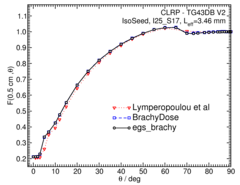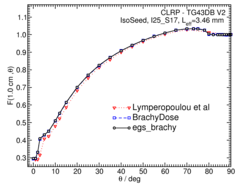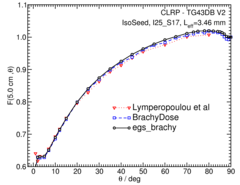
Source Description:
The IsoSeed I125.S17 1 source dimensions are taken from the study by Lymperopoulou et al 1. The source element for the IsoSeed is a cylindrical molybdenum rod with an outer diameter of 0.500 mm and a length of 3.40 mm. The rod is coated with a layer of nickel that is 3.0 μm thick. On top of the nickel is a 25.0 μm thick layer of silver which is in turn coated with a 2.0 μm thick layer of radioactive silver iodide. The titanium encapsulation has a 0.80 mm outer diameter and is 0.050 mm thick. End welds are 0.40 mm thick and hemispherical in shape. The overall source length is 4.5 mm and the active length of the source is 3.46 mm. The cylindrical source element is free to move 0.120 mm along the seed axis and 0.070 mm radially from the center of the seed. The mean photon energy calculated on the surface of the source is 27.28 keV with statistical uncertainties < 0.01%Dose-Rate Constant - Λ :
Dose-rate constants, Λ , are calculated by dividing the dose to water per history in a (0.1 mm)3 voxel centered on the reference position, (1 cm,Π/2), in the 30x30x30 cm3 water phantom, by the air-kerma strength per history (scored in vacuo). As described in ref. 2 , dose-rate constants are provided for air-kerma strength calculated using voxels of 2.66x2.66x0.05 cm3 (WAFAC) and 0.1x0.1x0.05 cm3 (point) located 10 cm from the source. The larger voxel size averages the air-kerma per history over a region covering roughly the same solid angle subtended by the primary collimator of the WAFAC 3,4 at NIST used for calibrating low-energy brachytherapy sources and is likely the most clinically relevant value. The small voxel serves to estimate the air kerma per history at a point on the transverse axis and includes a small 1/r2 correction (0.5%) 4 . egs_brachy and BrachDose MC uncertainties are statistical uncertainties only (k=1).
| Author | Method | Λ (cGy h-1 U-1) | Abs. Uncertainty |
| Safigholi et al 5 | WAFAC | 0.9173 | 0.0002 |
| Safigholi et al 5 | point | 0.9467 | 0.0015 |
| Taylor, Rogers 6 | WAFAC | 0.916 | 0.002 |
| Taylor, Rogers 6 | point | 0.941 | 0.003 |
| Lymperopoulou et al 1 | point (MCNP) | 0.944 | 0.014 |
| Lymperopoulou et al 1 | WAFAC (MCNP) | 0.914 | 0.014 |
| Lymperopoulou et al 1 | TLD | 0.951 | 0.044 |
| Pantelis et al 7 | Polymer gel (after 26 days) | 0.934 | 0.037 |
| Rodriguez, Rogers 8 | Revised TLD (Lymperopoulou) | 0.874 | 0.045 |
| Rodriguez, Rogers 8 | WAFAC (Brachydose) | 0.915 | 0.015 |
| Rivard et al 9 | TG43U1S2 | 0.933 | 0.025 |
Radial dose function - g(r):
The radial dose function, g(r), is calculated using both line and point source geometry functions and tabulated at 36 different radial distances ranging from 0.05 cm to 10 cm. Fit parameters for a modified polynomial expression are also provided 10 . The mean residual deviations from the actual data for the best fit were < 0.13%.
| Fitting coefficients for g L (r) = (a0 r-2 + a1 r-1 + a2 + a3r + a4r2 + a5 r3) e-a6r | |||
| Fit range | Coefficients | ||
| r min (cm) | r max (cm) | ||
| 0.05 | 10.0 | a0 / cm2 | (7.49+/-0.23)E-04 |
| a1 / cm | (-1.67+/-0.04)E-02 | ||
| a2 | (1.1739+/-0.0018)E+00 | ||
| a3 / cm-1 | (4.00+/-0.04)E-01 | ||
| a4 / cm-2 | (-3.33+/-0.34)E-03 | ||
| a5 / cm-3 | (1.80+/-0.07)E-03 | ||
| a6 / cm-1 | (4.434+/-0.022)E-01 | ||
Anisotropy function - F(r,θ):
Anisotropy functions are calculated using the line source approximation and tabulated at radii of 0.1, 0.15, 0.25, 0.5, 0.75, 1, 2, 3, 4, 5, 7.5 and 10 cm and 32 unique polar angles with a minimum resolution of 5 o . The anisotropy factor, φ an (r), was calculated by integrating the solid angle weighted dose rate over 0 o ≤ ϑ ≤ 90 o .
Tabulated data:
Tabulated data are available in .xlsx format: Excel
References:
1. G. Lymperopoulou et al , Monte Carlo and thermoluminescence dosimetry of the new IsoSeed model I125.S17 125I interstitial brachytherapy seed, Med. Phys., 32 , 3313 - 3317, 2005
2. R. E. P. Taylor et al , Benchmarking BrachyDose: voxel-based EGSnrc Monte Carlo calculations of TG-43 dosimetry parameters, Med. Phys., 34 , 445 - 457, 2007
3.R. Loevinger, Wide-angle free-air chamber for calibration of low--energy brachytherapy sources, Med. Phys., 20 , 907, 1993
4. S. M Seltzer et al , New National Air-Kerma-Strength Standards for 125I and 103Pd Brachytherapy Seeds, J. Res. Natl. Inst. Stand. Technol.,108,337-358,2003
5. H. Safigholi, M. J. P. Chamberland, R. E. P. Taylor, C. H. Allen, M. P. Martinov, D. W. O. Rogers, and R. M. Thomson, Update of the CLRP TG-43 parameter database for the brachytherapy, to be published (Current calculation) 6. R. E. P. Taylor, D. W. O. Rogers, An EGSnrc Monte Carlo-calculated database of TG-43 parameters, Med. Phys.,35 ,4228-4241,2008
7. E. Pantelis et al , Dose characterization of the new Bebig IsoSeed I25.S17 using polymer gel and MRI, Nucl. Instrum. Methods A, 569 , 529-532, 2006 8. M. Rodriguez and D. W. O. Rogers, Effect of improved TLD dosimetry on the determination of dose rate constants for 125I and 103Pd brachytherapy seeds, Med. Phys., 41, 114301, 2014. 9. M. J. Rivard et al , Supplement 2 for the 2004 update of the AAPM Task Group No. 43 Report: Joint recommendations by the AAPM and GEC-ESTRO, Med. Phys., 44 , e297-e338, 2017
10. R. E. P. Taylor, D. W. O. Rogers, More accurate fitting of 125I and 103Pd radial dose functions, Med. Phys., 35 , 4242-4250, 2008
Carleton Laboratory for Radiotherapy Physics
CLRP TG-43 Parameter Database V2
May 5, 2020



